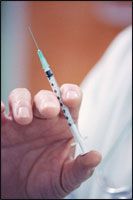Publication
Article
Pharmacy Times
CDC Recommends Herpes Zoster Vaccine for Older Adults
Author(s):
A closer look at the herpes zoster (shingles) vaccine, following the CDC's recent recommendation that adults aged 60 and older be vaccinated.
Ms. Terrie is a clinical pharmacy writer based in Haymarket, Virginia.
Herpes zoster, commonly referredto as shingles, is a painfulcondition caused by thereactivation of the latent varicella-zostervirus (VZV) within the sensoryganglia.1 Shingles is characterized byclusters of blisters that develop onone side of the body in a bandlike patternand can cause severe pain thatmay last for weeks, months, or years.2The Centers for Disease Control andPrevention (CDC) reports that 1 in 3individuals will develop herpes zosterin his or her lifetime,accounting for >1 millioncases annually.1,2
Risk Increaseswith Age

The incidence and severityof herpes zosterincreases with advancingage, starting at aroundage 50, and more than50% of all individualswho will develop herpeszoster are >60 years ofage.1-3 In addition, >50%of all persons living up to85 years of age have hador will develop shingles.2
Complications attributedto herpes zoster occur in almost 50%of older persons with the condition.3,4The most frequent debilitating complication,which also increases with advancingage, is postherpetic neuralgia, aneuropathic pain syndrome that persistsor develops after the dermatomal rashhas healed.1,4-6 Examples of other complicationsinclude conjunctivitis, uveitis,episcleritis, scleritis, retinitis, choroiditis,and optic neuritis.1 Although no clearlydefined causes for the reactivation of theVZV are known (other than increasingage), patients who are immunocompromisedare at risk for reactivation.7
The CDC's Advisory Committee onImmunization Practice announced onMay 15 its recommendation that individuals=60 years of age be vaccinatedagainst herpes zoster.1,2 This recommendationreplaces the provisional recommendationmade by the CDC in 2006.2
In June 2005, Oxman et al reportedin the New England Journal of Medicinethat the use of the zoster vaccine decreasedthe burden of illness due toherpes zoster by 61.1%; decreased theincidenceof postherpetic neuralgia by66.5%; and reducedthe incidence of herpeszoster by 51.3%.3 Inaddition, the study concludedthat the zostervaccine reduced themorbidity associatedwith herpes zoster andpostherpetic neuralgiaamong older adults.3
Zoster Vaccine
Zostavax (Merck & CoInc), which was approvedby the FDA onMay 25, 2006, is theonly available vaccine toprevent herpes zoster.It is available as a lyophilizedpreparation of live, attenuatedVZV.8 Zostavax is indicated for the preventionof herpes zoster in individuals≥60 years of age, including individualswho have reported a previous episodeof zoster or who have chronic medicalconditions, such as chronic renal failure,diabetes, rheumatoid arthritis, or chronicpulmonary disease, unless those conditionsor other comorbid conditions arecontraindicated for its use.1,8 Zostavax isnot indicated for the treatment of herpeszoster or postherpetic neuralgia.
The use of Zostavax is contraindicatedin individuals with a history of anaphylactic/anaphylactoid reaction to gelatin,neomycin, or any other component ofthe vaccine; individuals with a history ofprimary or acquired immunodeficiencystates; or those on immunosuppressivetherapy.8 Vaccination should be deferredin individuals with active untreated tuberculosis.It also is contraindicated inchildren, women of childbearing age,and should never be administered topregnant females.8
For more information on herpes zoster andthe zoster vaccine, go to the Centers forDisease Control and Prevention Web siteat www.cdc.gov/vaccines/vpd-vac/shingles/default.htm.
The vaccine should be stored frozenand reconstituted immediately uponremoval from the freezer. The diluentsupplied by the manufacturer can bestored at room or refrigerated temperature.Prior to administration, the vaccineshould be reconstituted with thediluent supplied by the manufacturerand should be administered immediatelyto minimize loss of potency. The vaccineshould be discarded if not used within 30minutes of reconstitution.
Zostavax should be administered asa single 0.65-mL dose subcutaneouslyin the deltoid region of the upper arm.The most common adverse reactionsare associated with site injection reactions,such as erythema, pain, tenderness,swelling, pruritus, hematoma, andwarmth.8 Examples of systemic reactionsreported include headache, fever,rhinitis, diarrhea, flu syndrome, respiratoryinfection, and asthenia.8
References
- Centers for Disease Control and Prevention Morbidity and Mortality Weekly Report Web site. Prevention of Herpes Zoster. Recommendations of the Advisory Committee on Immunization Practices (ACIP). www.cdc.gov/mmwr/preview/mmwrhtml/rr57e0515a1.htm. Accessed on May 28, 2008
- Centers for Disease Control and Prevention Web site. CDC Recommends Shingles Vaccine. www.cdc.gov/media/pressrel/2008/r080515.htm. Accessed on May 28, 2008.
- Oxman, MN, Levin MJ, Johnson GR, et al. A vaccine to prevent herpes zoster and postherpetic neuralgia in older adults. N Engl J Med. 2005;352(22):2271-2284.
- Oxman, MN. Clinical Manifestations of Herpes Zoster. In: Arvin AM, Gershon AA, eds. Varicella?Zoster Virus: Virology and Clinical Management. Cambridge, England: Cambridge University Press, 2000:246-275.
- Donahue JG, Choo PW, Manson JE, Platt R. The incidence of herpes zoster. Arch Intern Med. 1995;155:1605-1609.
- Dworkin RH, Portenoy RK. Pain and its persistence in herpes zoster. Pain. 1996;67:241-251.
- Herpes Zoster. In: Beers M, ed. The Merck Manual of Diagnosis and Therapy.18th Edition. Rahway, NJ: Merck Publishing; 2006:1609-1610.
- Zostavax [package insert]. Rahway, NJ: Merck & Co, Inc. www.zostavax.com







